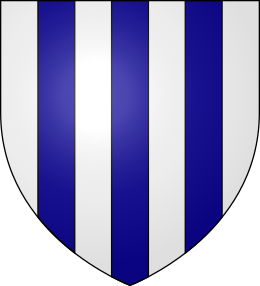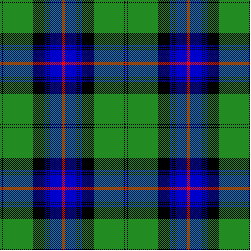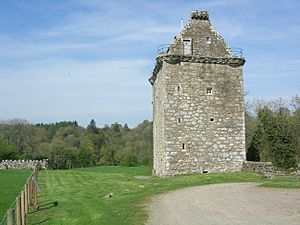Clan Armstrong facts for kids
Quick facts for kids Clan Armstrong |
|||
|---|---|---|---|
| Clann Mac Ghillielàidir | |||

Crest: An arm from the shoulder, armed, Proper
|
|||
| Motto | Invictus maneo (I remain unvanquished) | ||
| Profile | |||
| Region | Scottish Borders | ||
| District | Liddesdale | ||
 |
|||
| Clan Armstrong has no chief, and is an armigerous clan | |||
| Historic seat | Mangerton | ||
| Last Chief | Archibald Armstrong of Mangerton | ||
| Died | 1610 | ||
|
|||
The Clan Armstrong is a famous Scottish clan from the Scottish Borders area. They were known as a powerful and brave family. Their motto is Invictus maneo, which means "I remain unvanquished" in Latin.
Contents
History of the Armstrong Clan
How the Clan Began
Old Stories of Origin
According to old stories, the first person named Armstrong was Siward Beorn. He was a strong warrior, also known as Siward Digry, meaning "sword strong arm". People say he was the last Anglo-Danish Earl of Northumberland. He was also a nephew of King Canute, a Danish king of England.
Recorded Beginnings
The Armstrong name was common across the Scottish Borders. The Armstrongs grew into a strong and warlike clan in Liddesdale. They lived in an area called the Debatable Lands. A historian named George Fraser Black mentioned Adam Armstrong in 1235. He was forgiven for causing another man's death.
The Armstrongs traditionally supported Robert the Bruce during the Scottish Wars of Independence. Their relationship with the Scottish kings was often loyal in the 1300s. Alexander Armstrong, the second laird of Mangerton, was captured and killed. This happened at Hermitage Castle by William de Soulis, who was against Robert the Bruce.
Gilbert Armstrong worked for David II of Scotland, the king. He was in charge of the king's household and horses. He also traveled to England as an ambassador in 1363. Sir Adam Armstrong was allowed to travel outside Scotland in 1374. He went with the Earl of March and Dunbar, who defended the Scottish border. Later, in 1388, John Armstrong fought in an army at the Battle of Otterburn. In 1398, several Armstrongs promised to keep peace on the border.
The 15th, 16th, and 17th Centuries

Around 1425, John Armstrong built a strong tower. He was the brother of Armstrong of Mangerton. The Armstrongs could gather three thousand horsemen. They were said to control the Debatable Lands for a time.
In 1528, Lord Dacre, an English leader, attacked the Armstrongs' tower. The Armstrongs fought back and burned Netherby. James V of Scotland saw the Armstrongs' power as a threat. Legend says King James tricked John Armstrong of Gilnockie into a meeting. The king then had Johnnie executed at Hawick. King James continued to act against the Armstrongs. This happened when they did not support him in 1542 at the Battle of Solway Moss.
In 1603, the Union of the Crowns happened. This officially ended the Anglo-Scottish Wars in the Borders. In 1610, the last Armstrong laird was executed in Edinburgh. This was for leading a raid into Penrith, England. After this, the Crown worked hard to make the Borders peaceful. Many Armstrong families were scattered. They found new homes in Ulster, especially in County Fermanagh. Today, Armstrong is one of the most common names in Ulster.
There has been no known chief of the Armstrong clan since the 1600s. Even though they had a difficult relationship with the kings, some Armstrongs served in the royal armies. These armies fought for Charles I in the Wars of the Three Kingdoms. Sir Thomas Armstrong, a soldier, moved to Ireland in 1639. He fought for the king and was involved in plans against the government.
Modern Clan History
Many famous Armstrongs have lived throughout history. Sir Alexander Armstrong was an Arctic explorer. Neil Armstrong was the first person to walk on the Moon. He even took a piece of the Clan Armstrong tartan with him!
The Armstrong baronets are descendants of the Gilnockie family. Comedian Alexander Armstrong is also a descendant. Edwin Howard Armstrong, who invented FM Radio, is another famous descendant.
Even without a chief, the Clan Armstrong is still active. The Clan Armstrong Trust was started in 1978.
Armstrong Castles

The Clan Armstrong owned several castles. Some of these include:
- Gilnockie Tower: This tower is also called Hollows Tower. It is a few miles north of Canonbie in Dumfriesshire. It was likely built in 1518, but an older fort might have been there before. Today, it is home to a Clan Armstrong Centre.
- Mangerton Tower: This tower is one mile south of Newcastleton. It is close to the English border. Nearby is the Minholm Cross. This cross was put up around 1320. It remembers the killing of Alexander Armstrong at Hermitage Castle.
Gaelic Language and the Clan
We do not know if early Armstrongs spoke Gaelic. However, some place names in the area are from Gaelic. For example, Auchenrivock is in the Esk River valley. The Gaelic language was spoken in some parts of Scotland until the 1600s. So, it is possible some Armstrongs spoke it.
The name of the Armstrong stronghold, Gilnockie, comes from the Scottish Gaelic Geal Cnocan. This means 'Little White Hill'.
The Armstrong name is sometimes written in Gaelic as:
- MacGhillielàidir (for a single person)
- Clann 'icGhillelàidir (for the whole clan)
These Gaelic names are often used in modern clan writings. However, Gaelic speakers do not use them very often. Historically, Armstrong has been linked to the Ulster Gaelic name, Mac Tréan-Labhraidh. This name means strong-speaking. People think it was misunderstood to mean strong-arm. Because of this, Armstrong was used as an English version of the name.
See also
- Johnnie Armstrong
- Kinmont Willie Armstrong
- Border Reivers
- Bromley Armstrong

